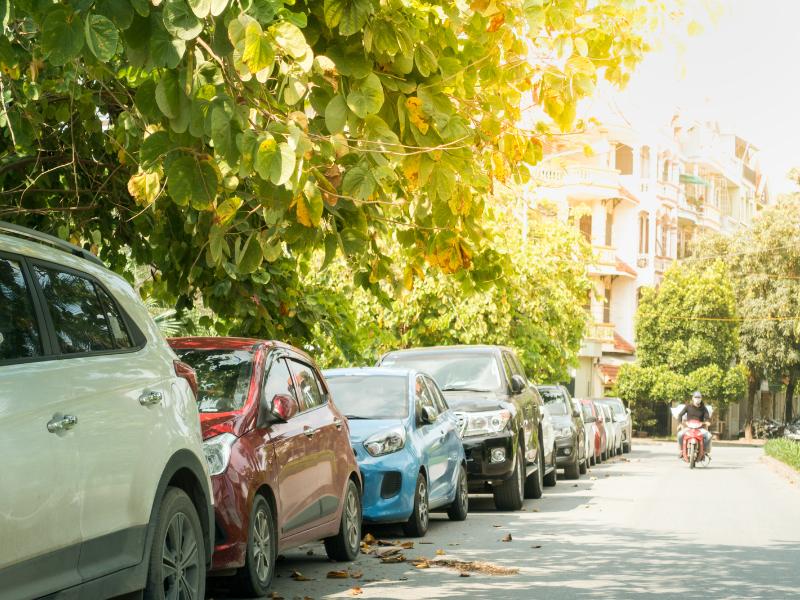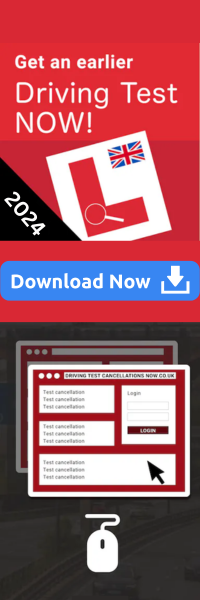The Top 5 Must-Know Driving Test Manoeuvres
Are you preparing for your driving test and eager to conquer the challenging driving test manoeuvres? Look no further!
This blog post is designed to help you master the essential driving test manoeuvres that will pave the way to getting your driving licence.
We will answer common questions such as:
- How many maneuvers are there in the driving test?
- Can you fail driving test on a manoeuvre?
- what manoeuvres are in the new driving test?
In this comprehensive blog post, we will guide you step-by-step through the process, ensuring you gain the necessary skills and confidence to pass your driving test with flying colors.
So, let’s jump in so you know what to expect on your practical driving test.
And if you want a bit more help, claim a copy of a learner driver checklist today.
Why is it important to know about the UK driving test maneouvers?

One common concern among learner drivers is whether they can fail their driving test solely based on their performance during a manoeuvre.
So, let’s address this question.
Can you fail driving test on a manoeuvre?
The short answer is yes, it is possible to fail your driving test if you struggle with a manoeuvre. The driving test assesses your overall ability to drive safely and confidently, which includes demonstrating competence in various manoeuvres.
Failing to execute a manoeuvre correctly may result in critical errors that could lead to a test failure.
However, you should understand that a single mistake or struggle with a manoeuvre doesn’t automatically guarantee failure. The driving test examiners evaluate your overall driving performance, including:
- observation
- control
- decision-making
- hazard awarenessThey take note of these throughout the entire test.
While manoeuvres are important to know, they are just one component of the evaluation process.
The key to success lies in thorough preparation and practice.
By focusing on mastering the essential driving test manoeuvres we discussed earlier, you increase your chances of performing well during the test.
Practice in various scenarios, such as different types of junctions, parking spaces, or roundabouts, to build confidence and adaptability.
During the test, remember to stay calm and composed. Even if you encounter challenges during a manoeuvre, you need to demonstrate good judgement, observation, and proper reaction to minimise errors.
Does anything other than driving test maneouvres affect passing the UK driving test?
Examiners take into account your overall performance and your ability to recover from mistakes.
You need to not only know the maneuvers, but, understand the purpose behind each. By grasping the underlying principles and practicing the correct techniques, you’ll be better equipped to navigate through the manoeuvres successfully.
Finally, don’t forget the importance of road safety. While performing manoeuvres, ensure that you prioritise safety, adhere to traffic rules, and remain aware of your surroundings.
So, while it is possible to fail your driving test due to struggles with manoeuvres, you need to learn them so you are prepared.
The Top 5 Must-Know Driving Test Manoeuvres
To equip you with the necessary skills, we have compiled a list of the top 5 must-know driving test manoeuvres.
Let’s explore each one in detail:
The Cockpit Drill
The cockpit drill, a fundamental aspect of safe driving, sets the stage for your success on the road.
By adjusting your mirrors, seat position, and familiarizing yourself with the vehicle’s controls, you ensure optimal visibility and comfort while driving, ultimately increasing your chances of passing the driving test.

Reverse Bay Parking
Mastering the skill of bay parking, specifically parking your car within the designated white lines while attentively observing other road users, is of utmost importance when preparing for a driving test.
Being knowledgeable and proficient in this aspect not only ensures a smoother driving experience but also enhances safety on the road for both yourself and others.
Bay parking is a fundamental maneuver that involves parking your vehicle within a designated bay or parking space.
It is commonly encountered in parking lots, shopping centers, and other areas where vehicles are required to be parked in an organized manner.
The ability to perform this maneuver accurately and efficiently demonstrates your control over the vehicle and your awareness of the surrounding environment.
When bay parking, you can take a systematic approach to maximise your chances of success. This typically involves the following steps:
- Approach
- Observe
- Steer in
- Align
- Adjust
- Parking brake
Remember, mastering bay parking not only contributes to your success in passing the driving test but also plays a vital role in real-world driving scenarios.
The ability to park efficiently within the designated lines ensures efficient use of parking spaces, minimises inconvenience to other drivers, and promotes a smoother flow of traffic.
Additionally, being observant of other road users during the maneuver showcases your attentiveness and consideration for the safety of others.
Investing time and effort into learning how to bay park proficiently demonstrates your commitment to becoming a responsible and skilled driver.
So, take advantage of the resources provided, practice the maneuver diligently, and strive to excel in bay parking to ensure a confident and successful driving test experience, as well as a safe and enjoyable journey on the roads.

Parallel Parking
RParallel parking refers to the process of parking a vehicle parallel to the kerb, between two parked cars, or within a designated parking space on the side of the road.
This manoeuvre is commonly encountered in urban areas, busy streets, and areas with limited parking options.
Proficiency in reverse parking demonstrates your ability to manoeuvre your vehicle accurately and safely in tight spaces, ensuring efficient use of parking areas and maintaining a smooth flow of traffic.
While reverse parking may seem complicated at first, it can be broken down into a systematic approach that simplifies the process.
The following steps are typically involved in reverse parking.
Positioning: Select a suitable spot to park, ensuring there is enough space for your vehicle.
Signal your intention to park and position your car parallel to the vehicle in front of the desired parking space, leaving a safe distance.
Observation: Before proceeding with the manoeuvre, thoroughly observe your surroundings. Check for pedestrians, cyclists, and other vehicles approaching or occupying the area.
Use your mirrors and blind spots to ensure it is safe to proceed.
Steering and Reverse: Begin by turning the steering wheel fully to the right (or left, depending on the side of the road you drive on) while shifting your vehicle into reverse gear.
Slowly release the brake and control the speed using the accelerator.
Angle and Mirrors: As you begin to reverse, monitor the angle of your vehicle by checking your side mirrors and rear-view mirror.
Adjust the steering wheel to maintain a proper angle while keeping a safe distance from the parked cars.
Reference Points: Utilise reference points, such as the position of your vehicle in relation to the parked cars or the kerb, to guide your manoeuvre.
These points assist in aligning your vehicle parallel to the kerb and within the designated parking space.
Final Adjustments: Once your vehicle is positioned correctly within the parking space, straighten your wheels by turning the steering wheel back to its original position.
Ensure you leave adequate space between your vehicle and the surrounding cars.
Parking Brake: Engage the parking brake to secure your vehicle in place.

Emergency Stop
An emergency stop is a sudden and forceful braking action used to swiftly bring the vehicle to a stop in an unexpected or hazardous situation. It may be required to avoid collisions with pedestrians, animals, or other vehicles that suddenly enter your path.
By practising and understanding the proper technique for an emergency stop, you can effectively respond to such situations, potentially preventing accidents and ensuring the safety of yourself and others on the road.
During a driving test, your ability to perform an emergency stop will be assessed by the examiner.
They will evaluate your reaction time, braking technique, control of the vehicle, and the ability to stop the car promptly and safely.
Therefore, it is crucial to familiarise yourself with the correct procedure for carrying out an emergency stop in order to increase your chances of passing the driving test.
To execute a well-controlled emergency stop, the following steps are typically involved:
Observation and Decision: Remain vigilant and scan the road ahead for any potential hazards. When confronted with an emergency situation, quickly assess the need for an emergency stop and make a decisive decision to apply the brakes.
Signal and Communication: Alert other road users by activating the hazard lights and ensure they are aware of your intention to make an emergency stop.
Braking Technique: Apply firm and progressive pressure to the brake pedal with your right foot. Maintain control of the steering wheel and avoid locking the wheels, which could lead to skidding.
Balance and Control: As you brake, shift your body weight slightly forward to maintain balance and stability. Keep both hands on the steering wheel to ensure control of the vehicle.
Stop and Assess: Bring the vehicle to a complete stop as quickly and safely as possible, without skidding or losing control. Once stopped, assess the situation and proceed accordingly.

Forward Bay Parking
Mastering the skill of forward bay parking, which involves driving forward into a parking bay and then reversing out, is an important ability for drivers to acquire.
While it may seem straightforward, this manoeuvre can pose challenges for new drivers and catch them off guard if not performed correctly.
Forward bay parking is a common parking technique used in various locations such as local car parks, shopping centres, and car parks.
It requires driving your vehicle into a designated parking bay, positioning it correctly within the lines, and subsequently reversing out when leaving.
While forward bay parking may initially appear deceptively simple, it can be broken down into a systematic approach to ensure accuracy and efficiency. The following steps are typically involved:
Approach: Choose an appropriate entry position aligned with the centre of the parking bay and begin moving forward slowly.
Observation: Before proceeding further, carefully observe your surroundings, including other vehicles, pedestrians, and any potential obstacles that may affect your parking. Ensure it is safe to continue.
Positioning: Align your vehicle parallel to the parked cars on either side of the bay, leaving sufficient space on both sides.
Progress: Gradually drive forward into the bay, maintaining a slow and controlled speed. Monitor your position in relation to the lines of the bay and adjust as necessary.
Alignment: Once positioned within the bay, ensure your vehicle is centred and aligned correctly between the white lines. Use your mirrors and rear-view camera (if available) to assist you.
Final Adjustments: Make any necessary adjustments to ensure your vehicle is parked within the lines, leaving equal space on either side. Double-check your position and correct as needed.
Reversing Out: When ready to leave the bay, check your surroundings again for any approaching vehicles or pedestrians. Reverse out slowly, keeping a close eye on your mirrors and blind spots.
Keep practicing these driving test maneouvers and you’ll be ready for your test in no time!
Once you have grasped these essential driving test manoeuvres, you’ll be ready to tackle more advanced driving skills.
With a structured plan and dedicated practice, you can build upon your foundation and master additional aspects, such as:
- dual carriageways
- following directions using a satnav
- Breakdown/emergency situations
Each step will enhance your driving abilities, ensuring a well-rounded skill set.
Congratulations on taking the first step toward becoming a confident and skilled driver.
You’re setting yourself up for success on your driving test!







0 Comments